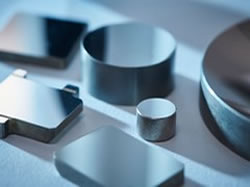Molybdenum
Solid molybdenum mirrors are used in high power CO2 laser welding where debris and back spatter would destroy other mirrors. They are also used in TEA lasers where the high pulse energies can cause localised melting on the face and thus initiate laser damage. In laser cutting the final mirror of the delivery system is often upgraded to a molybdenum one, as this is the most exposed and therefore most frequently damaged mirror.
Contact us for more information on Molybdenum
For infrared uses, polished uncoated molybdenum has a high natural broad band reflectivity of approximately 98%. The reflectivity falls steeply at less than 2um wavelength, so molybdenum mirrors are not used with Nd:YAG, fiber or disc lasers.
It's not just high power CO2 lasers that can benefit from molybdenum mirrors. Er:YAG lasers - especially surgical and dental laser systems - Quantum Cascade Lasers (QCL) for gas sensing and spectroscopy, in fact any infrared application longer than 2um wavelength that needs durable, tough, and chemically resistant mirrors benefit from using solid molybdenum mirrors. Read our Refectivity of Molybdenum laser mirrors pdf
Benefits of molybdenum mirrors
Uncoated solid Molybdenum (“Moly”) mirrors are simply the toughest, most durable, longest lasting laser mirrors available.
Molybdenum has the lowest thermal expansion of any commercially used metal and will withstand extreme temperatures without significantly expanding or softening. It has a Melting Point of 2,623 °C (4,753 °F).
Molybdenum mirrors need no coating; the extremely hard surface resists weld spatter, fumes, smoke and process debris. Molybdenum mirrors can be scrubbed with brushes, soak cleaned in organic solvents or detergents repeatedly.
Repolishing of used molybdenum mirrors is very cost effective and can be done many times if removed from service as part of a controlled maintenance plan.
Finally, the phase shift on reflection is very low and reliable (1 degree or so for CO2 laser) eliminating polarisation issues that interfere with sheet metal cutting.
Molybdenum mirrors are useful if a mirror has to be used facing upwards, so prone to collecting dirt and dust.
Mirror types and sizes
Molybdenum is difficult to machine so most mirrors are circular, with a diameter thickness ratio of 5:1. It is difficult to include threads or milled areas in the material and internal water cooling channels are not practical. Demanding tolerances on thickness and flatness should be avoided for molybdenum mirrors.
Most molybdenum mirrors are between 10mm and 80mm diameter, and although any size is possible it is most economical to use a standard mirror size made in quantity.
Extreme surface smoothness, obtainable on copper and aluminium is not possible with molybdenum. We cannot manufacture aspherics from Molybdenum.





.jpg)